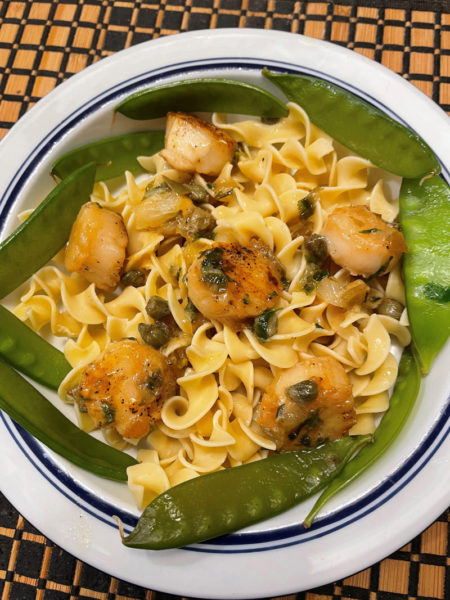
Scallops grenoblaise. (Photo courtesy I. Winicov Harrington)
Scallops, unlike other bivalves like clams and oysters, are harvested in winter months. So, from early December to March, we may expect those delicious plump bites of seafood to appear in stores and on our dinner plates. Scallops may be considered a luxury food because of their price is driven by methods of harvesting, often by hand, and each bivalve yields only a small edible muscle.
Scallops are a valuable seafood harvest for Maine, the coastal waters being home to bay scallops, with trawlers and deep-sea divers bringing up the larger sea scallops to our tables. The home cook needs to look for “dry” scallops that are natural and will give a flavorful texture when cooked. Cheaper “wet” scallops may appear plumper at the store but are treated with artificial preservatives that make scallops difficult to sear quickly and often add “off” flavors. Overcooking scallops makes them tough!
The following recipes all use “dry” scallops, can be used with both bay and sea scallops, but very large scallops may need to be cut in half before cooking.
Scallops grenobloise
This recipe was adapted from an old issue of Food and Wine and retains the strange title of a city in France notable for its leading scientific research centre and surrounding Alps. Serves two.
Peel the outer skin and pith from a lemon. Cut between membranes, remove the segments and cut them in 1/4-inch pieces. Squeeze any remaining juice on the pieces and set aside.
Sprinkle 12 large scallops with salt and pepper. Heat 2 tbsp olive oil in a nonstick skillet on medium heat and sear scallops for 3 minutes, turn, and cook until barely opaque for another 2 minutes. Transfer to a shallow bowl and cover to keep warm.
Melt 2 tbsp butter in the same pan on medium high heat, add 2 tbsp drained chopped capers and 1-2 tbsp chopped mild chilies. Cook until fragrant for 1-2 minutes, stir in lemon segments and 2 tbsp chopped fresh Italian parsley, 1/4 tsp salt, and 1/4 tsp lemon pepper. Cook to heat and pour sauce over scallops. Serve on wide pasta with steamed snow peas for added color.
Scallops with pine nuts

Scallops with pine nuts. (Photo courtesy I. Winicov Harrington)
Preheat oven to 500 degrees. Generously butter 4 shallow ramekins. Divide 1 lb scallops among the dishes. Serves four.
In a small skillet melt 1 tbsp butter and cook 4 finely chopped scallions on medium heat for 2 minutes with stirring. Melt 3 more tbsp butter and add 2 tbsp pine nuts, 1 tbsp chopped fresh dill, 1/3 cup fine breadcrumbs, and 1 tbsp fresh lemon juice. Mix all well and spread over the scallops in the ramekins. Bake for 10 minutes until bubbling at edges. Serve with lemon slices and a side of pasta, rice, or just crusty French bread.
For dessert, here is an interesting apple pie with cranberries that would grace any holiday table.
Dutch apple-cranberry pie
Preheat oven to 450 degrees. Prepare the streusel topping by blending 1/2 cup plus 1 tbsp flour, 1/2 tsp cinnamon, 1/4 tsp nutmeg, and 1/4 cup brown sugar, packed. Blend in with a pastry cutter or two knives 1/4 cup butter until it forms small crumbles, then stir in 1/4 cup Grape-Nuts.
Line a 9-inch pie pan with one ready-made rolled pie crust. Fit it well in bottom and flute on the edges of the pan. Blend 1/4 cup sugar with 1 tbsp flour and sprinkle over the bottom crust. Wash, pare, quarter, and thinly slice 2 apples over the sugar, sprinkle with 1/2 cup dried cranberries and another layer of 2-3 sliced apples, making sure the pie mounds a bit in the middle. Sprinkle all with 1/2 cup sugar and the streusel mix. Bake 15 minutes at 450 degrees, then lower the temperature to 350 degrees and bake for an additional 30 minutes. Remove pie to a rack to cool for 2-3 hours and serve.
Scallops may be pricey, but winter is a good time to savor these delightful morsels at their best. “All good things come in small packages!”
(I. Winicov Harrington, of Waldoboro, is the author of “How to Eat Healthy and Well for Less Than $5.00 a Day: The Smart-Frugal Food Plan” and “Uncharted Journey from Riga.” For more information, go to winicov-harrington.com.)



